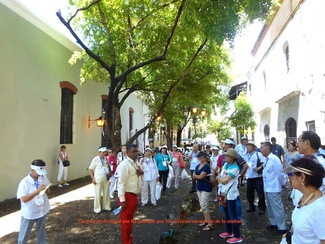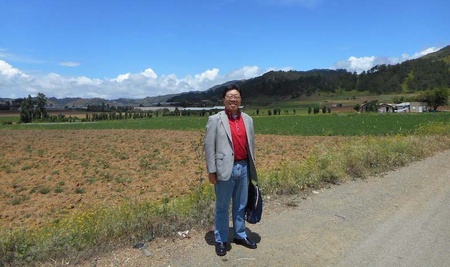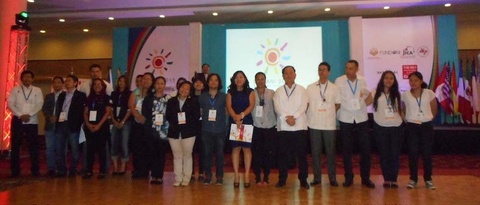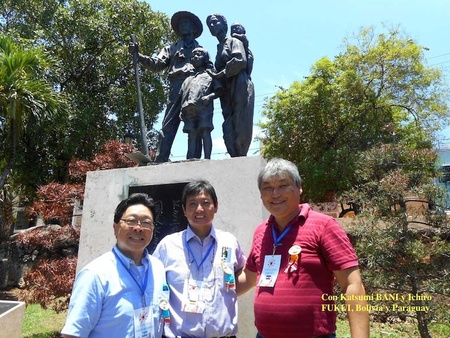In August 2015, I visited the Dominican Republic for the first time for five days. I went to participate in the 18th Pan American Convention of Japanese descendants (COPANI) held in the capital, Santo Domingo, and as a result, I was able to deepen my interactions with Japanese descendants in the country. Several years ago, JICA Japanese descendants trainees started coming from the country, and I had become quite close with some of them, so I had been looking forward to visiting the country someday.
There had been talk of hosting the event in the Dominican Republic since the Cancun event in Mexico four years ago, and it was decided that the event would be held in Buenos Aires in 2013. Over the past year, Nisei played a central role in preparing the event, overcoming various obstacles and realizing one of the most fulfilling events in the past decade. The participants were also captivated by the subcommittees, general meetings, city tours, and entertainment.
Although the local Japanese Association did not co-host the conference, second and third generation Japanese worked hard in cooperation with Japanese people in Mexico and other countries to make the conference a great success. It goes without saying that Carlos Kasuga of Mexico gave two lectures in Santo Domingo and used the proceeds from those lectures towards the conference preparations, which was a great encouragement.
In Japan, the Dominican Republic is famous for the Caribbean resort of Punta Cana, but what the media has reported so far is that it is a case of the failure of a postwar Japanese immigration program, in which some Japanese immigrants later sued the Japanese government, and in the appeals court, the Koizumi administration officially apologized and paid a lump sum to settle the case.1
Meanwhile, during the boom in Japanese migrant workers in South America in the 1990s, many people from the Dominican Republic came to Japan, and currently there are approximately 500 people living in Japan.2
Dominica is an island nation in the Caribbean with a population of 10 million. Its gross domestic product is $55.6 billion (equivalent to 6 trillion yen) and its average income per capita is $5,500, which is quite high for the region. However, the island is also home to Haiti, the poorest country in the world, and the increase in cross-border migrant labor is a major problem. In addition, there is serious internal disparity, with a poverty rate of 35% 3 . In fact, I saw more than a thousand Haitians lining up in front of the immigration office to apply for residence permits, which was quite a shocking sight. The Dominican government has implemented a special residence permit system as a measure against illegal immigrants, but only a small proportion of them are actually granted residence permits.
At the same time, the Dominican government has been strengthening border surveillance by sending in military forces, and recently the Dominican Consulate General in Haiti was temporarily closed. In retaliation, Haiti has restricted food imports from the Dominican Republic, causing considerable tension in relations between the two countries.4 Both policies have their limits, and there is a need for domestic human resource development and skill improvement, as well as domestic and foreign investment in industries that will create more jobs.
Tourism, mining, and agriculture are the main industries in Dominica, but the first two are heavily dependent on foreign investment. Although the island is in a subtropical region, there are several mountainous areas in the inland, and various crops are cultivated on the slopes and valleys at altitudes of 500 to 1,000 meters. Semi-processed and processed agricultural products, such as vegetables, are exported to neighboring countries and the United States.
The town of Constanza, where the Japanese community is located, is one of those valleys, at an altitude of 1,200 meters (150 km inland from the capital, in the central region). The municipality has a population of 60,000 (0.6% of the total), but accounts for 4% of the gross domestic product, and has the highest per capita income after the Santo Domingo metropolitan area and Santiago. Currently, there is an express bus service in the morning and evening, and it takes just under three hours to travel between the two towns.
I also visited the Japanese settlement of Constanza for a day trip. I visited the home of former JICA trainee, Yukari Waki, and was able to visit several Japanese families living in the neighborhood. Later, they attended the COPANI convention, interacted with Japanese descendants from other South American countries, and enjoyed a karaoke contest featuring Japanese singers from six countries. It was striking to see many of them in tears when it came to enka, as if they were feeling nostalgic for something. It was also moving to see the executive committee send letters of appreciation to the surviving first generation members, praising their achievements and efforts to date.
The conference was planned and carried out mainly by second-generation Japanese in cooperation with Japanese descendants from other Latin American countries. Usually, it is co-hosted by local Japanese associations and first-generation Japanese leaders attend as guests of honor along with representatives from the embassy and JICA, but unfortunately, despite repeated pleas from the executive committee chairman, the former were not present this time. Instead, Ambassador Fuchigami and his wife, Counsellor Miwa and his wife, other embassy staff, JICA Director Yamada and other staff members attended not only the opening ceremony but also the general lectures and closing ceremony. The executive committee and the Japanese descendants who attended the conference were impressed and highly praised this.
Even though the immigration lawsuit has already been settled legally and politically, some first-generation Japanese still hold grudges and are not trying to take healthy measures for the next generation. In today's complex world, horizontal connections (information networks) and the experience and know-how of other countries are more important than ever. There are many things that cannot be solved even with cooperation between Japanese descendants, but at least international meetings such as COPANI bring together influential Japanese descendants who play leading roles in each country, and the trust and friendship fostered there can broaden the range of options when coming up with an answer. Also, if we consider Japanese descendants as Japan's soft power, it can also strengthen relations with Japan depending on the time and situation.
Whether before or after the war, Japanese immigrants faced various problems and shortcomings in every country, and they overcame these limitations to realize their own small possibilities, survive, and grow. Not only in Peru and Brazil, but also in the postwar Amazonia, Bolivia, and Paraguay, many hardships and sacrifices were faced.
Migration from Europe to the Americas was even more tragic, with millions of people forced to cross the ocean due to war, political or religious persecution, and other factors, overcoming discrimination and misunderstanding without government support and making many mistakes before surviving.
In any country, second-generation immigrants and onward must aim for social integration as members of society more than first-generation immigrants, and they cannot develop in any profession or field without the trust and respect of the local community. The most extreme example is the Japanese-Americans in the United States, where 120,000 parents and siblings were sent to internment camps during the war, yet many second-generation immigrants volunteered to join the 442nd Regimental Combat Team and risked their lives to prove their loyalty to the United States (they were forced to do so).
In the case of the Japanese, their qualities of hard work, unity, perseverance and persistence have enabled them to achieve great results in every country, despite being a minority.
Needless to say, the purpose of the Pan-American Japanese Convention is to bring together Japanese people with different backgrounds and histories in one place every two years to deepen exchanges, foster friendships, and seek ways to cooperate with each other. As a result of holding these meetings for over 30 years, even if not fully, the participants have learned a lot, and Japanese people throughout the Americas are connected, even if indirectly.
For the Japanese community in the Dominican Republic, hosting this conference was a big challenge, but I hope that together with their new friends, they will contribute more than ever to the development of society as a whole. Also, in Cuba, which is close but far away in the same Caribbean Sea, there are 1,200 Japanese people who have had very limited contact with the outside world, so I hope that in the future, together with their friends in the Dominican Republic, they will aim to build a channel of communication with the Japanese people in Cuba.
Notes:
1. The number of Japanese in the Dominican Republic is currently around 800, but migration from Japan took place between 1957 and 1959. Many of them were from Kagoshima Prefecture, and 1,319 people from 249 households emigrated. The land in Dajabón, close to the Haiti border, was so poor that it was impossible to even maintain a basic standard of living. A few years later, with the support of the Japanese government, many of them returned to Japan, and some even moved to Brazil and Argentina. In 2000, 126 plaintiffs filed a lawsuit against the Japanese government seeking 2.5 billion yen in damages. The government's liability was found in the first instance, but the claim for damages was dismissed due to the statute of limitations. An appeal was made, but a settlement was reached under the Koizumi administration, and the case was settled with a special lump sum payment of 2 million yen per plaintiff (1.3 million yen for plaintiffs living in Japan) and 1.2 million yen for non-plaintiffs living in the Dominican Republic (500,000 yen for non-plaintiffs living in Japan).
2. According to the Immigration Bureau's statistics on foreign residents (June 2015), there are 466 Dominican residents. Of these, 165 live in Kanagawa Prefecture, 43 in Tokyo, 35 in Aichi Prefecture, 32 in Saitama Prefecture, and 20 in Osaka Prefecture and Chiba Prefecture.
3. According to local media reports, the poverty rate has been reduced by 6.7% over the past few years and currently stands at 35.5%.
" The Dominican Republic confirms that it can reduce poverty by 6.7% in the last years " (America Economics)
4. Since last year, a special permit system has been established to legalize illegal residents, and about 300,000 foreigners have applied for it so far. Most of them are from neighboring Haiti, but it has been reported that less than 10% of them have been granted permission. Some have returned to their home countries before being deported, but many have been living in the Dominican Republic for decades. The reality is that most of them do not have proper residence status.
" Dominic Republic of China issues concerns on poverty and aggravated crimes " (American Economist)
© 2015 Alberto J. Matsumoto










